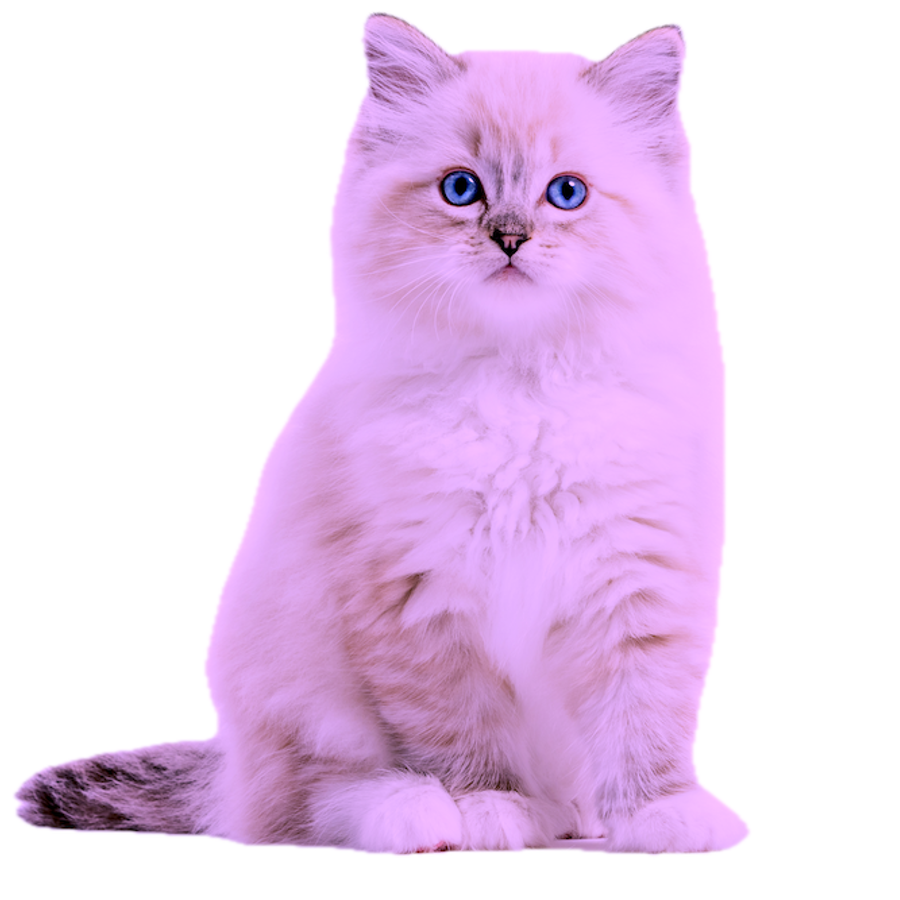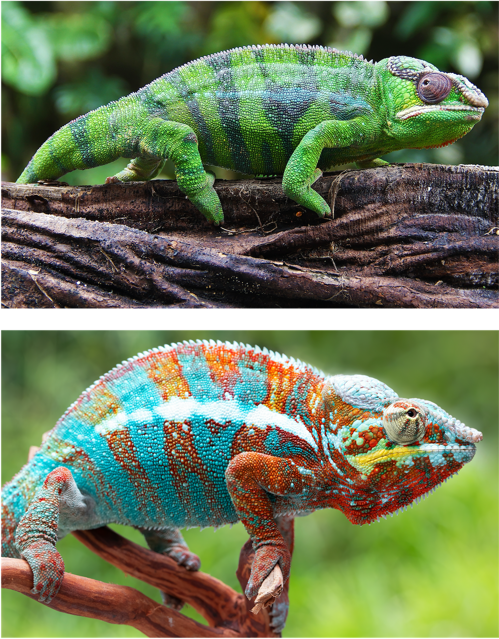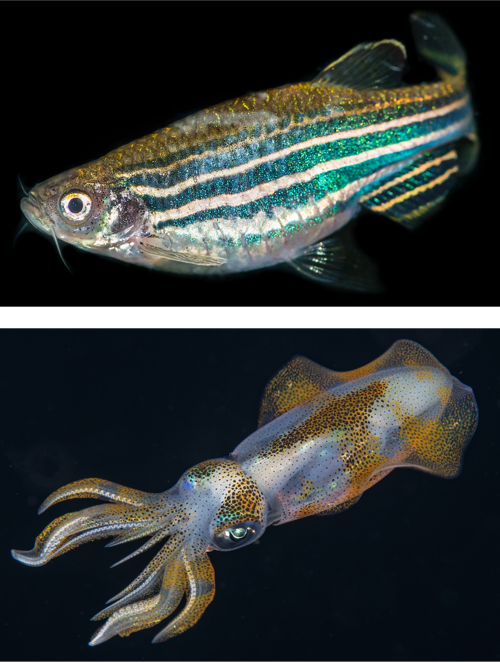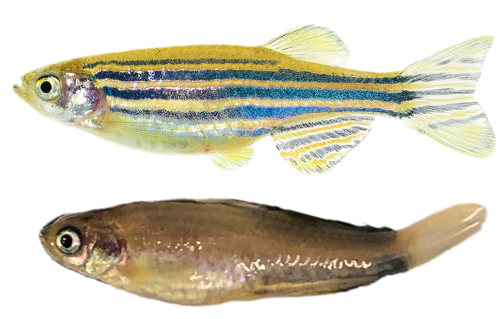
Could we create cats that change color like a chameleon?
June 24, 2024

- Related Topics:
- Futuristic science,
- Pigmentation traits,
- Complex traits,
- Animal biology
Lyle from Tennessee asks:
"Is it possible to give the chameleon color change gene to other animals? Example, in a cat, the ability to change fur color."
Chameleons are famous across time and media for their ability to change color. Just imagine a cuddly kitten purring in your lap and turning pink with love!
Sadly the chameleon’s ability to change colors is complicated. There isn’t a single “color change gene” we can give to mammals to create a color changing kitten or puppy. Still, by understanding how chameleons and mammals make their colors, we could design something close to a color-changing cat-meleon!
How does color work? (aka: why is this text purple?)
Making color text on a screen is easy. For instance, this red text looks red because tiny red lights in the computer screen are making red light that your eyes can see. Black text is black because none of the little lights in the computer screen glow underneath the text. The white background is actually created by a mixture of all the screen’s lights glowing equally bright.
But how are trees green if they don’t have their own little green LEDs? Well, everything that doesn’t glow takes light from the sun, or whatever light source might be around. The light of the sun or a lamp is actually an equal mixture of all the colors of the rainbow, just like the white in your computer screen. Tree leaves absorb the red and blue parts of the light and reflect the green back into your eyes. So tree leaves appear green because they absorb all light except the green part.
Reflecting specific colors of light is key to a chameleon’s color-changing ability.
How does chameleon coloration work?
Scientists used to think that chameleons change color by moving around a dark pigment called melanin that they share with humans, other lizards and most other vertebrates. This is partially true — chameleons do move melanin around to change the vibrancy of their colors. However, male chameleons can do much more than make their colors a little brighter. Male chameleons can change their normal green to a rainbow of reds, blues, and even purples when they’re excited by a rival male or pretty lady chameleon.

This more dramatic color change is what would be the most fun to have in a house cat. Just imagine, when your new kitten starts playing with a mouse on a string and turns into a bright array of reds, blues and purples!
This sort of change doesn’t rely on moving pigments in the skin, but instead changing which colors of light the chameleon’s skin reflects back into your eyes.
Chameleons get their unique reflective powers from a special type of cell called an iridophore. Iridophores get their shine from stacks of teeny tiny crystals. These crystals bounce around any light that hits them and then shine it back out into the world. These cells are even shared with many other animals including fish and squids!

The striking color-changing ability of the chameleon comes not only from the presence of these iridophores, but from the way chameleons arrange and control them. By arranging them in a specific, repeating pattern, the chameleons reflect only greens and browns, allowing them to blend into their environment. They can then use little muscles in their skin to change the spacing of the shiny cells, similar to how you get goosebumps when you’re scared or when a cat raises its hair when threatened. By changing the spacing of the shiny cells, chameleons can change the color the cells reflect to produce the astonishing color change they’re famous for and which we want to recreate in our cat-meleon.

Because the chameleon’s color change ability is so complex, it's caused by lots of genes working together rather than a single “color change gene”. Some genes make the shiny iridophores. Other genes make sure the shiny cell spacing is correct. Even more genes make the little muscles that can change the spacing of the cells to make them reflect different colors.
Ok let’s get down to it: what about a cat-meleon?
So with this understanding of chameleon color, we know that making our cat-meleon will require making a number of different structures. We need to make iridophores, make sure they’re spaced regularly, and make muscles that can control their spacing. It is unlikely that we can build all of those structures with the addition of a single gene.
Still, sometimes it is that easy. There are a number of examples in nature where seemingly complex features can easily be put into other species. My favorite example is when chicks were given dinosaurian teeth with the addition of a single gene!
The first step for our cat-meleon is to give cats the shiny iridophores they need to reflect light. So is there a single gene that could give cats iridophores? Well lucky you asked because scientists (actually this specific scientist with the help of her lab — science is a team sport) found just the gene we need… at least in fish. When a gene called ALX4 is added to the fish’s dark pigment cells, it turns them into shiny cells to produce a totally shiny fish!

Sadly, this trick probably won’t work in mammals. Mammals actually use this gene to build our faces. So if we tried to turn on ALX4 in a cat’s pigment cells, it probably wouldn’t convert them into iridophores. It would likely cause them to self-destruct, or turn into something needed to make your face (like bone).
Even if we could give cat’s iridophores, we’d next want them to be able to control the iridophores to make different colors.
Chameleons change their colors by changing the iridophore spacing. So, our cat would have to change the spacing of their hairs to make different colors. For this we might actually be in luck. Cats already have this ability! While a cat’s hairs usually sit flat against their skin, they can raise them to stand straight up when they’re excited or threatened. This changes the distance between the hairs and might be enough to change the color the cat reflects back to our eyes.
Still, the chameleon produces its bright, specific colors through a strict geometric arrangement of iridophores. Cats don’t arrange their hair follicles so strictly, so we might just see two different tones of silver, rather than a switch from brown to red like in the chameleon.
Consolation prize: a pol-cat-meleon
We can’t easily give cats iridophores, but are there any other ways to adjust their hair to reflect different colors? For example, could we find a mammal that uses reflection to make its color? Well, the world is large and mammals can be very, very weird! You’ve probably even heard of one: the polar bear.
Polar bears are especially cool, not just because they live in the arctic, but because their hair is actually clear! So why do they appear white? Well, remember, “white” is just what we see when all colors of light are reflected back to our eye equally. When light hits polar bear fur, it bounces around in that forest of clear hairs, and all colors of light are reflected back, making the bear appear white.
Making a cat with the reflective fur of a polar bear would be much easier than making a cat with iridophores. This is because clear fur doesn’t require a whole new cell type, it would only change the way the cat uses its normal pigment cells. A lab at Stanford has even found the mutation that likely creates the polar bear’s clear fur. This mutation could probably be given to other mammals with little fear of creating unexpected effects. Researchers at Stanford have even given the mutation to mice without any ill effects.
Still, giving a cat reflective hair is only the first step. We’d also want it to make more colors than just shades of white. A cat's natural “hair raising” abilities might be able to adjust the exact shade of white their coat reflected, but it's unlikely to produce the dramatic color change we want.
We might be able to make different colors by arranging the hairs in specific patterns, like the chameleons do with their shiny cells. If this didn’t work, we could try changing the structure of the hairs themselves. However, arranging the hair and changing the hair structure requires altering even more genes. We would need to perform many experiments to see which adjustments to what genes we would need to create each color. While the polar bear offers a tantalizing bridge to our cat-meleon, it's still a long road to a true, color-changing cat-meleon.
Sadly our cat-meleon will probably live only in the realm of science fiction… for the near future at least. With the work of some dedicated pigment scientists, I can see something like a color-changing cat-meleon coming to our homes, and our hearts someday.
Read More:
- More on chameleon’s shiny cells
- Another breakdown of chameleon color
- Scientists use tiny lights to make a color changing robot
- Scientists discover how cats get their stripes and spots
- Read more on how polar bear fur reflects light
- Polar bear fur isn’t cool, it's hot! See how it helps the bears stay warm in the harsh arctic.
- Chickens can have dinosaur teeth with the addition of one gene!
- Horses can change color too! Just over years and not with emotions. For example, gray horses are born colored and “gray out” over time and appaloosas change their spots every time they shed out their old fur.

Author: Ali Wilkening
When this answer was published in 2024, Ali was a PhD candidate in the Department of Developmental Biology at Stanford University in the Sanulli Lab. There, she studied how the squishiness of a protein that helps to package DNA (a histone) helps baby cells decide what they’ll be when they grow up. She previously worked in the Wang Lab at Washington University in St. Louis where she discovered a gene that tells baby pigment cells they will become iridophores (shiny cells) when they grow up.
 Skip Navigation
Skip Navigation
